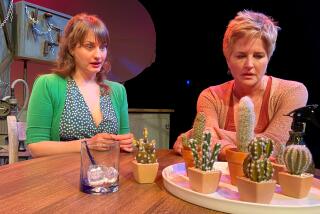TV REVIEW : ‘Lucifer’s Child:’ A Television Show Made for Radio
- Share via
“Lucifer’s Child,” William Luce’s one-woman bio-play on Danish storyteller Isak Dinesen,” may have been extremely listenable on Broadway, but it is extremely unwatchable on television.
Like Luce’s other solo plays designed for actor Julie Harris (most notably “The Belle of Amherst”), a free-thinking, eccentric woman out of history appears before us and talks, talks, talks to us about her life and loves and ideas. By this point, Luce has this down to a format, which is one of many reasons why “Lucifer’s Child” feels inert on the screen.
But the very concept of an actor dressed up as Dinesen, speaking directly to the camera, is such a temptation of the TV demons that you have to wonder what Luce, as teleplay adapter, and director Tony Abatemarco (a leading light of the wonderful Hollywood theater, Stages, and this play’s Broadway director) were thinking.
If it included the notion that directly transferring the stage production to TV (including the set, props and glorious costumes) would extend Dinesen’s and theater’s popularity, then “Lucifer’s Child” is a cultural disaster. It does for the author and theater what bad teachers do for Shakespeare.
Harris’ Dinesen tells us about her amazing life as a Dane whose heart belongs to Africa, where she tended to her family’s coffee plantation for years and encountered the love of her life in Denys Finch Hatton (slightly fictionalized in “Out of Africa”). As Luce conceives her, she is more concerned with telling us about her “Egyptian beauty secrets” (though not all of them) than her views on the writing art. It’s like hearing Picasso regale us about his women, and forget to tell us about painting.
The only way solo theater ever works is if the character is at war with herself, but this Dinesen is just an aging repository of memories and syphilitic aches and pains. Luce bends over backward to inject hot topics from rain forest depletion and ivory poaching to sexually-transmitted diseases, and the strain shows.
The uneven makeup shows, too; Dinesen’s distinctive clown-white face and jet-black eyes keep changing on Harris’ face from scene to scene--and the camera magnifies every continuity glitch. Indeed, almost everything that’s interesting in Harris’ performance is aural: Listen to her masterly, musical control of the play’s language, and it’s clear that the real home for “Lucifer’s Child” is the radio.
* “Lucifer’s Child” airs at 6 and 10 tonight on the A&E; cable channel.
More to Read
The complete guide to home viewing
Get Screen Gab for everything about the TV shows and streaming movies everyone’s talking about.
You may occasionally receive promotional content from the Los Angeles Times.






